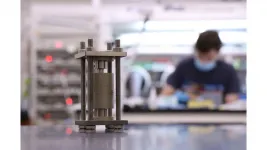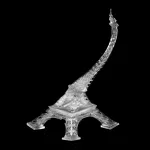Using the ultrabright X-rays of the Advanced Photon Source (APS), a U.S. Department of Energy (DOE) Office of Science User Facility at the DOE's Argonne National Laboratory, a research team recently observed the internal evolution of the materials inside solid-state lithium batteries as they were charged and discharged. This detailed 3D information may help improve the reliability and performance of the batteries, which use solid materials to replace the flammable liquid electrolytes in existing lithium-ion batteries.
"There is substantial commercial and scientific interest in this area, and information from this study should help advance this technology toward broad commercial applications." -- Matthew McDowell, Georgia Institute of Technology
Using a small (roughly two millimeters wide) cylindrical battery, researchers at APS beamline 2-BM were able to capture 3D images of structural changes during the battery charge and discharge cycles as they happened.
"The main features of this beamline that made this research possible are the high sensitivity and very fast speed," said Francesco De Carlo, group leader with Argonne's X-ray Science division and a co-author on the paper. "The sensitivity helped the team differentiate between phases inside the battery with similar densities, and the speed allowed them to capture the changes inside the battery while the process was evolving."
These clear images revealed how the dynamic changes of electrode materials at lithium/solid-electrolyte interfaces determine the behavior of solid-state batteries. The researchers found that battery operation caused tiny voids -- resolved up to 1-2 microns in size, about 50 times smaller than the width of a human hair -- to form at the interface, which created a loss of contact that was the primary cause of failure in the cells.
"This work provides fundamental understanding of what is happening inside the battery, and that information should be important for guiding engineering efforts that will push these batteries closer to commercial reality in the next several years," said Matthew McDowell, an author on the paper and an assistant professor in the George W. Woodruff School of Mechanical Engineering and the School of Materials Science and Engineering at the Georgia Institute of Technology. "We were able to understand exactly how and where voids form at the interface, and then relate that to battery performance."
The research was reported January 28 in the journal Nature Materials.
The lithium-ion batteries now in widespread use for everything from mobile electronics to electric vehicles rely on a liquid electrolyte to carry ions back and forth between electrodes within the battery during charge and discharge cycles. The liquid uniformly coats the electrodes, allowing free movement of the ions.
Rapidly-evolving solid state battery technology instead uses a solid electrolyte, which should help boost energy density and improve the safety of future batteries. But removal of lithium from electrodes can create voids at interfaces that cause reliability issues that limit how long the batteries can operate.
"To counter this, you could imagine creating structured interfaces through different deposition processes to try to maintain contact through the cycling process," McDowell said. "Careful control and engineering of these interface structures will be very important for future solid-state battery development, and what we learned here could help us design interfaces."
The Georgia Tech research team, led by first author and graduate student Jack Lewis, built special test cells which were designed to be studied at beamline 2-BM of the APS. Four members of the team studied the changes in battery structure during a five-day period of intensive experiments using X-ray computed tomography.
"The instrument takes images from different directions, and you reconstruct them using computer algorithms to provide 3D images of the batteries over time," McDowell said. "We did this imaging while we were charging and discharging the batteries to visualize how things were changing inside the batteries as they operated."
Because lithium is so light, imaging it with X-rays can be challenging and required a special design of the test battery cells. The technology used at Argonne is similar to what is used for medical computed tomography (CT) scans. "Instead of imaging people, we were imaging batteries," he said.
Because of limitations in the testing, the researchers were only able to observe the structure of the batteries through a single cycle. In future work, McDowell would like to see what happens over additional cycles, and whether the structure somehow adapts to the creation and filling of voids. The researchers believe the results would likely apply to other electrolyte formulations, and that the characterization technique could be used to obtain information about other battery processes.
De Carlo also noted that a possible next step might be nanotomography, which uses a more tightly focused X-ray beam and can deliver pictures of even smaller voids in the batteries, should they form during operation. This technique is also possible at the APS.
Battery packs for electric vehicles must withstand at least a thousand cycles during a projected 150,000-mile lifetime. While solid-state batteries with lithium metal electrodes can offer more energy for a given size battery, that advantage won't overcome existing technology unless they can provide comparable lifetimes.
"We are very excited about the technological prospects for solid-state batteries," McDowell said. "There is substantial commercial and scientific interest in this area, and information from this study should help advance this technology toward broad commercial applications."
INFORMATION:
In addition to those already mentioned, co-authors included Francisco Javier Quintero Cortes, Yuhgene Liu, John C. Miers, Jared Tippens, Dhruv Prakash, Thomas S. Marchese, Sang Yun Han, Chanhee Lee, Pralav P. Shetty and Christopher Saldana from Georgia Tech; Ankit Verma, Bairav S. Vishnugopi and Partha P. Mukherjee from Purdue University; Hyun-Wook Lee from Ulsan National Institute of Science and Technology; and Pavel Shevchenko from Argonne National Laboratory.
About the Advanced Photon Source
The U. S. Department of Energy Office of Science's Advanced Photon Source (APS) at Argonne National Laboratory is one of the world's most productive X-ray light source facilities. The APS provides high-brightness X-ray beams to a diverse community of researchers in materials science, chemistry, condensed matter physics, the life and environmental sciences, and applied research. These X-rays are ideally suited for explorations of materials and biological structures; elemental distribution; chemical, magnetic, electronic states; and a wide range of technologically important engineering systems from batteries to fuel injector sprays, all of which are the foundations of our nation's economic, technological, and physical well-being. Each year, more than 5,000 researchers use the APS to produce over 2,000 publications detailing impactful discoveries, and solve more vital biological protein structures than users of any other X-ray light source research facility. APS scientists and engineers innovate technology that is at the heart of advancing accelerator and light-source operations. This includes the insertion devices that produce extreme-brightness X-rays prized by researchers, lenses that focus the X-rays down to a few nanometers, instrumentation that maximizes the way the X-rays interact with samples being studied, and software that gathers and manages the massive quantity of data resulting from discovery research at the APS.
This research used resources of the Advanced Photon Source, a U.S. DOE Office of Science User Facility operated for the DOE Office of Science by Argonne National Laboratory under Contract No. DE-AC02-06CH11357.
Argonne National Laboratory seeks solutions to pressing national problems in science and technology. The nation's first national laboratory, Argonne conducts leading-edge basic and applied scientific research in virtually every scientific discipline. Argonne researchers work closely with researchers from hundreds of companies, universities, and federal, state and municipal agencies to help them solve their specific problems, advance America's scientific leadership and prepare the nation for a better future. With employees from more than 60 nations, Argonne is managed by UChicago Argonne, LLC for the U.S. Department of Energy's Office of Science.
The U.S. Department of Energy's Office of Science is the single largest supporter of basic research in the physical sciences in the United States and is working to address some of the most pressing challenges of our time. For more information, visit https://energy.gov/science.





